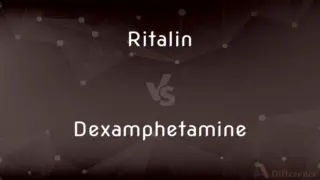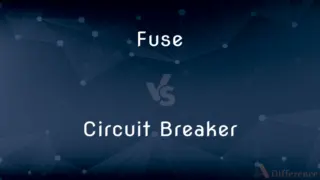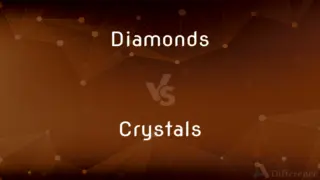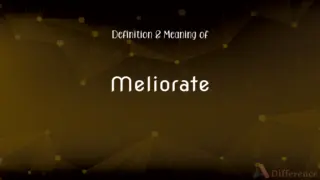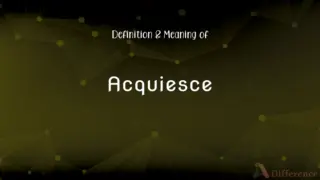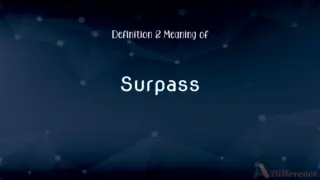Magnetar vs. Quark — What's the Difference?
By Tayyaba Rehman & Urooj Arif — Updated on May 21, 2024
A magnetar is a type of neutron star with an extremely strong magnetic field, while a quark is a fundamental particle that is a building block of protons and neutrons.

Difference Between Magnetar and Quark
Table of Contents
ADVERTISEMENT
Key Differences
A magnetar is a highly magnetic neutron star, formed from the remnants of supernova explosions. These stars possess magnetic fields trillions of times stronger than Earth's, influencing their surroundings dramatically. Quarks, on the other hand, are elementary particles and fundamental constituents of matter. They combine to form protons and neutrons, which in turn make up atomic nuclei. Quarks come in six types, or "flavors": up, down, charm, strange, top, and bottom.
While magnetars are astronomical objects on a macro scale, quarks operate at the subatomic level. Magnetars affect the cosmos with their powerful magnetic fields and energy emissions, whereas quarks are essential for the structure of matter itself.
Magnetars are rare and among the most extreme objects in the universe, often studied in astrophysics for their unique properties. Quarks, being fundamental particles, are a primary focus in particle physics, revealing the nature of the universe at the smallest scales.
Magnetars and quarks represent vastly different scales and realms of physics, with magnetars embodying extreme astrophysical phenomena and quarks underpinning the fundamental structure of matter.
Comparison Chart
Definition
Type of neutron star with a strong magnetic field
Fundamental particle that makes up protons and neutrons
ADVERTISEMENT
Scale
Astronomical
Subatomic
Magnetic Field
Extremely strong, trillions of times Earth's
N/A
Formation
Remnant of a supernova explosion
Elemental particle in particle physics
Types
One type, highly magnetic neutron star
Six flavors: up, down, charm, strange, top, bottom
Field of Study
Astrophysics
Particle physics
Energy Emission
X-rays, gamma rays
N/A
Structure
Affected by intense magnetic fields
Combine to form protons and neutrons
Interaction
Influences surrounding space
Interacts via the strong force
Rarity
Very rare
Fundamental and ubiquitous in matter
Compare with Definitions
Magnetar
Possesses magnetic fields trillions of times stronger than Earth's.
The magnetar's magnetic field can distort the shape of atoms.
Quark
A fundamental particle that makes up protons and neutrons.
Quarks combine to form the nucleus of an atom.
Magnetar
An astronomical object formed from a supernova remnant.
Magnetars are studied to understand extreme magnetic fields in space.
Quark
Comes in six flavors: up, down, charm, strange, top, and bottom.
Protons consist of two up quarks and one down quark.
Magnetar
Known for high-energy electromagnetic emissions.
The sudden flare from the magnetar puzzled scientists.
Quark
Interacts via the exchange of gluons.
The strong force between quarks is mediated by gluons.
Magnetar
A neutron star with an extremely strong magnetic field.
The magnetar emitted a burst of gamma rays detected by astronomers.
Quark
A quark () is a type of elementary particle and a fundamental constituent of matter. Quarks combine to form composite particles called hadrons, the most stable of which are protons and neutrons, the components of atomic nuclei.
Magnetar
Often the source of soft gamma repeaters and anomalous X-ray pulsars.
The magnetar's behavior was consistent with an anomalous X-ray pulsar.
Quark
Any of a class of six fundamental fermions, two in each of the three generations, one having an electric charge of - 1/3 , the other, + 2/3 , comprising the down, up, strange, charm, bottom, and top quarks. Quarks are the basic components of all hadrons.
Magnetar
A magnetar is a type of neutron star believed to have an extremely powerful magnetic field (∼109 to 1011 T, ∼1013 to 1015 G). The magnetic-field decay powers the emission of high-energy electromagnetic radiation, particularly X-rays and gamma rays.
Quark
Any of the six quarks' associated antiparticles, the antiquarks.
Magnetar
A neutron star with a very strong magnetic field. Magnetars are the proposed sources of observed gamma-ray bursts.
Quark
A soft, creamy, usually unsalted cheese traditional to central Europe and made from cow's milk that is coagulated by the lactic acid produced by bacteria rather than by the use of rennet.
Magnetar
(star) A neutron star or pulsar with an extremely powerful magnetic field, especially those on which starquakes occur, thought to be the source of some gamma-ray bursts.
Quark
(particle) In the Standard Model, an elementary subatomic particle that forms matter. They combine to form hadrons, such as protons and neutrons. Category:en:Nuclear physics
Quark
An integer that uniquely identifies a text string.
Quark
A soft creamy cheese, eaten throughout northern, central, eastern, and southeastern Europe as well as the Low Countries, very similar to cottage cheese except that it is usually not made with rennet.
Quark
The black-crowned night heron, Nycticorax nycticorax.
Quark
Hypothetical truly fundamental particle in mesons and baryons; there are supposed to be six flavors of quarks (and their antiquarks), which come in pairs; each has an electric charge of +2/3 or -1/3
Quark
Fresh unripened cheese of a smooth texture made from pasteurized milk, a starter, and rennet
Quark
Never found in isolation due to the strong force.
Quarks are always bound together in particles like protons and neutrons.
Quark
A key component in the Standard Model of particle physics.
Understanding quarks is essential for modern particle physics theories.
Common Curiosities
What makes magnetars unique?
Their extremely strong magnetic fields and high-energy emissions make magnetars unique.
What is a quark?
A quark is a fundamental particle that makes up protons and neutrons.
Do magnetars emit radiation?
Yes, magnetars emit high-energy electromagnetic radiation, including X-rays and gamma rays.
Can quarks be found alone?
No, quarks are never found alone due to the strong force; they are always in combination.
How do quarks combine?
Quarks combine to form protons and neutrons, which are components of atomic nuclei.
How strong are magnetar magnetic fields?
Magnetar magnetic fields are trillions of times stronger than Earth's magnetic field.
Are magnetars common?
No, magnetars are very rare.
How are magnetars formed?
Magnetars are formed from the remnants of supernova explosions.
What is a magnetar?
A magnetar is a type of neutron star with an extremely strong magnetic field.
Are quarks part of everyday matter?
Yes, quarks are fundamental components of all matter.
What are the six flavors of quarks?
The six flavors of quarks are up, down, charm, strange, top, and bottom.
What field studies magnetars?
Astrophysics studies magnetars.
What field studies quarks?
Particle physics studies quarks.
What phenomena are associated with magnetars?
Magnetars are associated with phenomena like soft gamma repeaters and anomalous X-ray pulsars.
What force binds quarks together?
The strong force binds quarks together.
Share Your Discovery

Previous Comparison
Gastric vs. Acidity
Next Comparison
Jr vs. IIAuthor Spotlight
Written by
Tayyaba RehmanTayyaba Rehman is a distinguished writer, currently serving as a primary contributor to askdifference.com. As a researcher in semantics and etymology, Tayyaba's passion for the complexity of languages and their distinctions has found a perfect home on the platform. Tayyaba delves into the intricacies of language, distinguishing between commonly confused words and phrases, thereby providing clarity for readers worldwide.
Co-written by
Urooj ArifUrooj is a skilled content writer at Ask Difference, known for her exceptional ability to simplify complex topics into engaging and informative content. With a passion for research and a flair for clear, concise writing, she consistently delivers articles that resonate with our diverse audience.
















